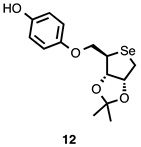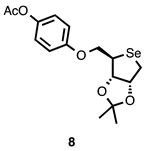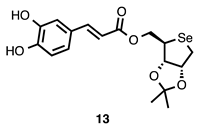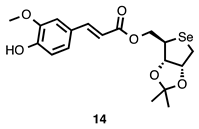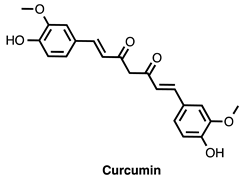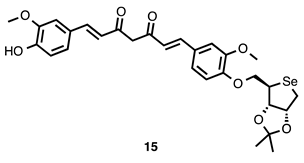Abstract
A simple and efficient route for the synthesis of new glycoconjugates has been developed. The approach acts as a model for a mini-library of compounds with a deoxy-selenosugar core joined to a polyphenolic moiety with well-known antioxidant properties. An unexpected stereocontrol detected in the Mitsunobu key reaction led to the most attractive product showing a natural d-configuration. Thus, we were able to obtain the target molecules from the commercially available d-ribose via a shorter and convenient sequence of reactions.
1. Introduction
In the last decade, a large amount of evidence has suggested a link to oxidative stress (OS) and ageing-related neurodegenerative diseases (NDs) [1,2], which are characterized by progressive damage in neural cells as well as by a selective loss of neuronal populations. Since OS refers to an imbalance between the production and removal of reactive oxygen species (ROS), antioxidant therapies have been proposed to prevent or attenuate their induced damage [3,4].
Recently, the therapeutic effects of several small molecules, normally taken with the diet, have been studied and their potential applications proposed. In more detail, several selenium-containing compounds have been synthesized, and they turned out to be potent neuroprotective agents with a modest effect on normal tissues and are clinically well tolerated [5,6]. Among them, the best known is the Ebselen [7] (Figure 1), a small organoselenium compound that acts as a glutathione peroxidase (GPx) mimetic. Likewise, several polyphenolic molecules have shown a strong antioxidant activity [8,9], including caffeic acid, which has the potential to modulate oxidation and inflammation, as demonstrated in several studies [10]; curcumin, with proven anticancer and anti-inflammatory characteristics [11,12]; and dopamine, whose loss is involved in the early phase of Alzheimer’s Disease (AD) development [13].
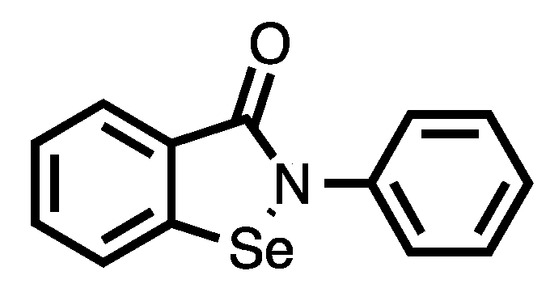
Figure 1.
Ebselen.
Faced with setting up a library of new antioxidant glycoconjugates to address the formulation of supplements focused on neurodegenerative disorders such as AD, we investigated the design and synthesis of new molecules combining the antioxidant properties of selenium with the chelating and antioxidant properties of a phenolic structure moiety, as displayed in the Scheme 1.
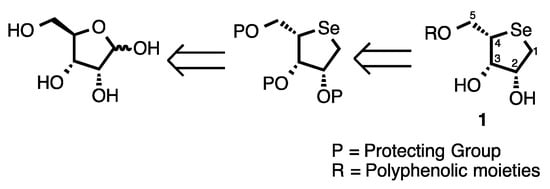
Scheme 1.
Retrosynthesis of target.
The introduction of selenium into organic structures has been performed via chemo-, regio-, and stereoselective methods, such as nucleophile, electrophile, and radical techniques only during the past three decades, challenging the well-known instability and unusual behavior of early derivatives [14]. The results of Matsuda [15], Pinto [16], and Jeong [17] represent the starting approach towards the chemistry of selenium-ribose compounds.
Inspired by these studies and taking into account that, to the best of our knowledge, no examples of 4-selenosugar-5-conjugates have been described in the literature to date; we wish to report their first synthesis here.
2. Results and Discussion
As outlined in the retrosynthetic path (Scheme 1), we started from the commercially available d-ribose. In fact, the latter was converted into the corresponding deoxy-selenosugar derivative 1, modifying a procedure reported by Jeong et al. [18].
Firstly, we protected d-ribose with orthogonal groups, with a view of selectively removing them during the synthetic strategy. In detail, isopropylidene was used to protect hydroxyl groups in C-2 and C-3 through a protocol [19] already described, characterized by smooth reaction conditions with a low environmental impact leading to compound 2 with a 95% yield. The O-isopropilydene derivative, without any further time consuming work up or purification procedures and after treatment with tert-butyl(chloro)diphenylsilane (TBDPSCl), triethylamine (TEA), and dimethylaminopyridine (DMAP) in anhydrous CH2Cl2, afforded the silyl ether 3, which in turn provided the diol 4 with an excellent yield (>99%) under reductive conditions (sodium borohydride). The next step where the diol 4 was converted to the corresponding dimesylate 5 allowed us to enter good leaving groups on C-1 and C-4 so that the subsequent treatment of 5 with selenium in the presence of sodium borohydride in EtOH-THF at 60 °C gave the deoxy-selenosugar derivative 6 at a 95% yield. It is noteworthy that the reaction takes place with inversion of the configuration [16,17,18], thus leading to the corresponding l-deoxy-selenosugar. Using dry conditions allowed the optimization of the procedure [18], providing 6 with a 99% yield (Scheme 2). Finally, the removal of the TBDPS protecting group on C-5 exploiting the great affinity of fluoride to silicon afforded the seleno building block 7 with a high yield (75% overall yield).
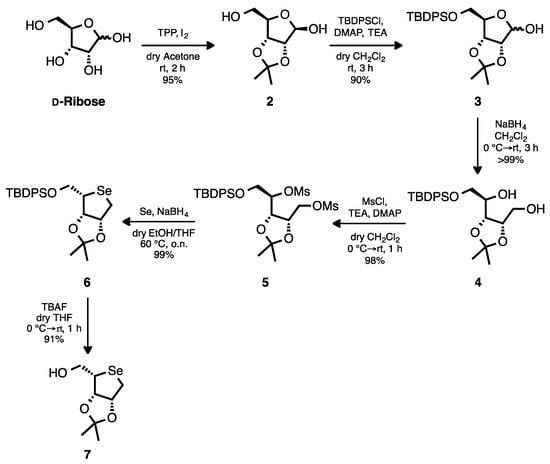
Scheme 2.
Synthesis of building block 7.
To perform the reaction giving the glycoconjugate, we attempted to convert 7 to an iododerivative using a triphenylphosphine polymer-bound/iodine complex already reported on different substrates [20], but the only product found was the dimer, probably resulting from the quick formation of the corresponding iodide that was attacked by the OH group of the remaining 7. It was not possible to evaluate the efficiency of mesyl or tosyl derivatives, since both were prepared in very low yields. The failed results prompted us to take a different approach based on the Mitsunobu reaction, which is well-known and carried out with an activated alcohol prepared in situ using triphenylphosphine (TPP) and an azodicarboxylate as promoter.
Therefore, our investigation began with the coupling of the seleno derivative 7 TPP-complex with monoacetylated hydroquinone [21] chosen as a model compound. The reaction in dry THF after three days gave a 43%-yield compound 8 as a major and unexpected product (Scheme 3).
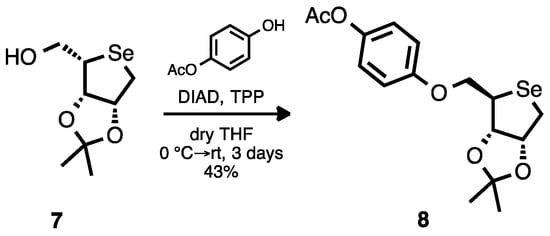
Scheme 3.
Mitsunobu reaction.
NMR was used to assign the configuration at C4 in the latter. It is well-known that the stereostructure of the furanose moiety is often difficult to analyze due to the low energy barriers between various puckering states [22]. It has already been reported in the literature that the bulky selenium atom in the 4′-selenoribonuclesosides led to a south (C2′-endo) pucker state [17]. However, since significant NOE effects were not detected for the hydrogens at C2 and C4 and the coupling constants of 8 were not supportive for the stereochemistry assignment with certainty, we decided to evaluate the outcome of the d-deoxy-selenosugar derivative 11 coming from the commercially available d-ribonolactone (Scheme 4). Thus, we employed the procedure reported by Batra et al. [23] to accomplish a first inversion of the configuration leading to the intermediate 9, which, in turn, was converted with a high yield into the corresponding d-target 11, using the same route previously described for his isomer 7.

Scheme 4.
Synthesis of the isomer of 7.
A comparative analysis of 1H NMR coupling constants in compounds 6 and 10 as well as 7 and 11 (Table 1) was therefore carried out to investigate the range of the vicinal coupling constants. The 3J3,2 medium value was 5.6 Hz, the 3J2,1b was 4.8 Hz, and the 3J2,1a was 2.0 Hz. More interestingly, however, was that for 6 and 7, the 3J3,4 medium value was 4.3 Hz, while for 10 and 11, the same coupling value was 1.6 Hz. Taking this into account, in glycoconjugates, the 3J3,4 medium value of 1.6 Hz is consistent with the 3,4-anti-configuration [15].

Table 1.
Vicinal coupling constants. Comparative analysis.
The selectivity seen in the model reaction, whose mechanism is under investigation, was also detected when the scope of our approach was explored. Indeed, all polyphenolic substrates used gave the sole corresponding d-deoxy-seleno glycoconjugate (8, and 12–15, Table 2). Moreover, when we performed the Mitsunobu reaction on the same polyphenols using the isomer 11 as the starting seleno substrate, the spectral and analytical data clearly indicated we had obtained the same product 8 and 12–15 with corresponding comparable yields (Table 2). These results, presumably resulting from the already reported unusual behavior of selenium [24], support the use in future of the “l-route” (seven steps up to isomer 7, overall yield 75%) to obtain further products, thereby avoiding the alternative time and products consuming “d-route” (eight steps up to isomer 11, overall yield 47%).

Table 2.
Scope with respect to polyphenolic substrates 1.
In the preliminary attempts performed on hydroquinone used as a model compound, the presence of a hydroxyl group different from the one involved in the reaction appeared to be a limit of reactivity for the methodology, thus affording a very low yield of the desired conjugated. On the other hand, the reaction on the monoacetylated hydroquinone proceeded with fair yields.
A different approach was reserved for curcumin, whose hydroxyl groups in C-4 have not been intentionally protected due to known handling problems of the molecule. Nevertheless, the yield was reasonable with the challenging purification procedure currently under improvement.
Concerning the polyphenols having the COOH group in addition to the phenolic one (caffeic and ferulic acids), as expected, due to the lower pka of the carboxyl group, they proved to be excellent substrates for the reaction (yields 67–72%), taking into account that we used a protecting-free approach, which is very useful in multistep programs.
The removal of the isopropylidene group on C-2 and C-3 (Scheme 5) under acid conditions provided, except for the curcumin, the corresponding derivatives 12a–14a (yield 68–80%) that will be investigated for their reducing and scavenging abilities consistent with the mechanism generally accepted for antioxidant compounds.
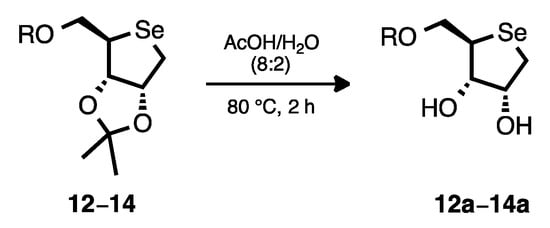
Scheme 5.
Removal of protecting group.
3. Materials and Methods
All the reagents were acquired (Aldrich, Fluka, Sigma) at the highest purity available and used without further purification. Thin-layer chromatography was performed with silicagel plates Merck 60 F254, and the display of the products on TLC was accomplished with UV lamp lighting, molecular iodine, and in H2SO4–EtOH (95:5) with further heating until the development of color. The column chromatographies were carried out using 70–230 mesh silica gel (Merck). The NMR spectra (Supplementary Materials) were recorded on Bruker DRX (400MHz) and Varian Inova Marker (500MHz) spectrometers in CDCl3 solution unless otherwise specified. The chemical shifts are reported in ppm (δ). The 1H and 13C NMR full characterization of the products was obtained based on 2D NMR and 1D selective NOESY. The TopSpin 4.0.6 software package was used for the analysis.
- Preparation of 2,3-O-isopropylidene-b-d-ribofuranose (2): To a magnetically stirred suspension of anhydrous triphenylphosphine (0.525 g, ca. 2.0 mmol) in anhydrous acetone (6.0 mL) at r.t., a solution of I2 (0.508 g, 2.0 mmol) in the same solvent (18.0 mL) was added dropwise in the dark and under dry N2 atmosphere. After 15 min, solid d-ribose (0.150 g, 1.0 mmol) was added in one portion to the suspension. TLC monitoring (CHCl3–MeOH, 9:1) showed that the starting sugar was completely consumed within 30 min. The reaction mixture was then filtered, washed with acetone, and dried (Na2SO4). The evaporation of the solvent under reduced pressure gave a crude residue that was used directly in the next step without further purification (0.181 g, 0.95 mmol, 95%). 1H NMR (500 MHz): δ 1.33 (s, 3 H, CH3), 1.48 (s, 3 H, CH3), 3.70 (dd, J5a,5b = 11.6, J5a,4 = 1.5, 1H, H5a), 3.79 (dd, J5b,5a = 11.6, J5b,4 = 1.8, 1 H, H5b), 4.30 (m, 1 H, H4), 4.51 (d, J2,3 = 6.1 Hz, 1 H, H2), 4.84 (dd, J3,2 = 6.1, J3,4 = 1.0 Hz, 1 H, H3), 5.06 (bs, 1 H, H1β). 13C NMR (125 MHz): δ 24.8, 26.4, 65.2, 81.9, 86.5, 87.7, 106.7, 111.9. Anal. Calcd for C8H14O5: C, 50.52; H, 7.42. Found: C, 50.60; H, 7.40. The NMR spectral data were identical to values in the literature [19].
- Preparation of 5-O-tert-butyldiphenylsilyl-2,3-O-isopropylidene-d-ribofuranose (3): TEA (0.28 mL, 2.0 mmol), DMAP (0.024 g, 0.2 mmol), and TBDPSCl (0.26 mL, 1.5 mmol) at 0 °C were added to a magnetically stirred solution of 2 (0.190 g, 1.0 mmol) in anhydrous CH2Cl2 (5.0 mL). The mixture was stirred at room temperature for 4 h. As soon as the starting compound 2 was completely consumed (TLC monitoring), the organic layer was washed with brine and dried (Na2SO4). The evaporation of the solvent under reduced pressure gave a crude residue that was purified by silica gel column chromatography (hexane-ethyl acetate 97:3 (v/v)) to give the oily product 3 as a yellowish syrup (0.386 g, 0.90 mmol, 90%). The product was obtained as a mixture of both anomers, but the βanomer was the main product (α:β, 1:1.9). 1H NMR (500 MHz): δ 1.08 (s, 9Hα, CH3), 1.12 (s, 9Hβ,CH3), 1.34 (s, 3Hβ,CH3), 1.42 (s, 3Hα CH3), 1.50 (s, 3H, 3Hβ,CH3), 1.58 (s, 3Hα, CH3), 3.71–3.63 (m, 2H, H5aα+β), 3.87–3.81 (m, 2H, H5bα+β), 3.96 (d, JOH,1α = 11.4 Hz, 1H, OHα), 4.18 (m, 1H, H4α), 4.31 (m, 1H, H4 β),4.51 (d, JOH,1β = 10.6 Hz, 1H, OHβ), 4.63 (d, J2,3 = 5.9 Hz, 1H, H2β), 4.68 (dd, J2,3 = 6.2 Hz, J2,1 = 4.0 Hz, 1H, H2α), 4.74 (d, J3,2 = 5.9 Hz, 1H, H3β), 4.80 (d, J3,2 = 6.2 Hz, 1H, H3α), 5.37 (d, J1,OH = 10.6 Hz, 1H, H1β), 5.64 (dd, J1,OH = 11.4 Hz, J1,2 = 4.0 Hz, 1H, H1α), 7.53–7.64 (m, 20H, Arα+β); 13C NMR (125 MHz): δ 19.1, 22.6, 25.0, 26.5, 27.0, 65.5, 66.1, 81.6, 87.1, 87.4, 98.0, 103.4, 127.7, 127.9, 128.0, 129.7, 130.2, 130.4, 134.8, 135.6, 135.7. Anal. Calcd for C24H32O5Si: C, 67.26; H, 5.53. Found: C, 67.31; H, 5.63.
- Preparation of 5-O-tert-butyldiphenylsilyl-2,3-O-isopropylidene-d-ribitol (4): To a magnetically stirred solution of 3 (0.429 g, 1.0 mmol) in MeOH (10.0 mL), NaBH4 (0.113 g, 4.0 mmol) at 0 °C was added. The mixture was stirred at room temperature for 2.5 h. As soon as the starting compound 3 was completely consumed (TLC monitoring), the solvent was evaporated under reduced pressure and replaced with AcOEt. The organic layer was washed with brine and dried (Na2SO4). The evaporation of the solvent under reduced pressure gave the pure product 4 as a colorless syrup (0.430 g, 1.0 mmol, >99%). 1H NMR (400 MHz): δ 1.10 (s, 9H, CH3), 1.31 (s, 3H, CH3), 1.33 (s, 3H, CH3), 3.10 (m, 2H, H4 and OH), 3.77–3.93 (m, 4H, H1 and H5), 4.14 (m, 1H, H2), 4.38 (m, 1H, H3), 7.40–7.46 (m, 6H, Ar), 7.67–7.70 (m, 4H, Ar); 13C NMR (125 MHz): δ 19.3, 25.2, 26.9, 27.7, 60.9, 65.3, 69.7, 76.5, 77.6, 108.5, 127.8, 130.0, 132.8, 132.9, 135.6. Anal. Calcd for C24H34O5Si: C, 66.94; H, 7.96. Found: C, 66.91; H, 7.93.
- Preparation of 5-O-tert-butyldiphenylsilyl-2,3-O-isopropylidene-1,4-di-O-methanesulfonyl-d-ribitol (5): DMAP (0.002 g, 0.02 mmol), TEA (1.1 mL, 8.0 mmol), and mesylchloride (0.309 mL, 4.0 mmol) at 0 °C were added to a magnetically stirred solution of 4 (0.430 g, 1.0 mmol) in CH2Cl2 (14.0 mL), and the mixture was stirred at room temperature overnight. The organic layer was washed with brine and dried (Na2SO4). The evaporation of the solvent under reduced pressure gave a crude residue that was purified by silica gel column chromatography (hexane-ethyl acetate 6:4 (v/v)) to give the oily product 5 as a yellowish syrup (0.575 g, 0.98 mmol, 98%). 1H NMR (500 MHz): δ 1.11 (s, 9H, CH3), 1.38 (s, 3H, CH3), 1.43 (s, 3H, CH3), 3.06 (s, 6H, CH3), 4.00 (dd, J5a,5b = 12.2 Hz, J5a,4 = 3.8 Hz, 1H, H5a), 4.07 (dd, J5b,5a = 12.2 Hz, J5b,4 = 2.7 Hz, 1H, H5b), 4.34 (dd, J1a,1b = 10.4 Hz, J1a,2 = 6.4 Hz, 1H, H1a), 4.46–4.54 (m, 3H, H1b, H2 and H3), 4.85 (m, 1H, H4), 7.40–7.49 (m, 6H, Ar), 7.73–7.67 (m, 4H, Ar); 13C NMR (125 MHz): δ 19.3, 25.4, 26.8, 27.4, 37.5, 39.3, 63.1, 68.3, 73.8, 74.9, 79.2, 109.5, 127.9, 130.1, 132.4, 132.5, 135.6. Anal. Calcd for C26H38O9S2Si: C, 53.22; H, 6.53. Found: C, 53.23; H, 6.43.
- Preparation of 5-O-tert-butyldiphenylsilyl-1,4-deoxy-2,3-O-isopropylidene-4-seleno-l-lyxose (6): NaBH4 was added to a magnetically stirred suspension of selenium powder (0.166 g, 2.1 mmol) in dry ethanol (13 mL) under N2 atmosphere, and the mixture was stirred at room temperature until the color of the mixture changed from black to colorless. Then, compound 5 (0.586 g, 1 mmol) in dry THF (8 mL) was added to the mixture, which was heated at 60 °C overnight. Then, the solvent was removed and replaced with AcOEt. Next, the organic layer was washed with brine and dried (Na2SO4). The evaporation of the solvent under reduced pressure gave the pure seleno derivative 6 as a pale-yellow oil (0.470 g, 0.99 mmol, 99%). 1H NMR (500 MHz): δ 1.08 (s, 9H, CH3), 1.30 (s, 3H, CH3), 1.48 (s, 3H, CH3), 2.97 (dd, J1a,1b = 12.2 Hz, J1a,2 = 1.5 Hz, 1H, H1a), 3.03 (dd, J1b,1a = 12.2 Hz, J1b,2 = 4.7 Hz, 1H, H1b), 3.77 (m, 1H, H4), 3.93 (dd, J5a,5b = 10.2 Hz, J5a,4 = 7.9 Hz, 1H, H5a), 4.15 (dd, J5b,5a = 10.2 Hz, J5b,4 = 7.1 Hz, 1H, H5b), 4.77 (m, 1H, H2), 4.94 (dd, J3,2 = 5.3 Hz, J3,4 = 4.5 Hz, 1H, H3), 7.37–7.47 (m, 6H, Ar), 7.72 (ddd, J = 11.0, 7.9, 1.4 Hz, 4H, Ar); 13C NMR (125 MHz): δ 19.3, 24.7, 26.1, 26.8, 29.8, 50.5, 63.0, 83.3, 84.9, 110.3, 127.6, 127.7, 129.6, 129.7, 133.5, 133.6, 135.7, 135.7. Anal. Calcd for C24H32O3SeSi: C, 60.62; H, 6.78. Found: C, 60.59; H, 6.83.
- Under the above conditions, 5-O-tert-butyldiphenylsilyl-1,4-deoxy-2,3-O-isopropylidene-4-seleno-d-ribose (10) was obtained as a pale-yellow oil (96%) starting from the C4 isomer of compound 5: 1H NMR (400 MHz): δ 1.09 (s, 9H, CH3), 1.33 (s, 3H, CH3), 1.54 (s, 3H, CH3), 2.96 (dd, J1a,1b = 11.8 Hz, J1a,2 = 2.3 Hz, 1, H, H1a), 3.20 (dd, J1b,1a = 11.8 Hz, J1b,2 = 5.1 Hz, 1, H, H1b), 3.67 (ddt, J4,5a = 7.3 Hz, J4,5b = 5.3 Hz, J4,3 = 1.8 Hz, 1H, H4), 3.74 (dd, J5a,5b = 10.5 Hz, J5a,4 = 7.0 Hz, 1H, H5a), 3.88 (dd, J5b,5a = 10.5 Hz, J5b,4 = 5.4 Hz, 1H, H5b), 4.80 (dd, J3,2 = 5.3 Hz, J3,4 = 1.8 Hz, 1H, H3), 4.86 (ddd, J2,1b = 5.5 Hz, J2,3 = 5.4 Hz, J2,1a = 2.3 Hz, 1H, H2), 7.38–7.47 (m, 6H, Ar), 7.65–7.72 (m, 4H, Ar); 13C NMR (100 MHz): δ 19.2, 24.7, 26.9, 29.6, 50.1, 64.5, 85.1, 87.3, 110.3, 127.7, 129.8, 133.1, 135.6. Anal. Calcd for C24H32O3SeSi: C, 60.62; H, 6.78. Found: C, 60.63; H, 6.79.
- Preparation of 1,4-deoxy-2,3-O-isopropylidene-4-seleno-l-lyxose (7): A solution of tetrabutylammonium fluoride (1.7 mL of a 1.1 M solution in THF, 2.0 mmol) was added to a magnetically stirred solution of seleno derivative 6 (0.475 g, 1.0 mmol) in anhydrous THF (7.0 mL) at 0 °C under N2, and the mixture was stirred at room temperature for 1 h. The evaporation of the solvent under reduced pressure gave a crude residue that was purified by silica gel column chromatography (hexane-ethyl acetate 6:4 (v/v)) to give the pure product 7 as a crystalline white solid (0.216 g, 0.91 mmol, 91%). 1H NMR (500 MHz): δ 1.33 (s, 3H, CH3), 1.53 (s, 3H, CH3), 2.53 (brs, 1H, OH), 2.99–3.05 (m, 2H, H1), 3.66 (dt, J4,5b = 7.5 Hz, J4,5a = 5.0 Hz, J4,3 = 4.2 Hz, 1H, H4), 3.91 (dd, J5a,5b = 11.5 Hz, J5a,4 = 5.0 Hz, 1H, H5a), 4.00 (dd, J5b,5a = 11.5 Hz, J5b,4 = 7.5 Hz, 1H, H5b), 4.87 (m, 1H, H3), 4.94 (ddd, J2,3 = 6.1 Hz, J2,1b = 4.1 Hz, J2,1a = 2.0 Hz, 1H, H2); 13C NMR (125 MHz): δ 24.5, 26.1, 29.0, 48.2, 62.2, 85.0, 85.1, 111.5. Anal. Calcd for C8H14O3Se: C, 40.52; H, 5.95. Found: C, 40.49; H, 5.96.
- Under the above conditions, 1,4-deoxy-2,3-O-isopropylidene-4-seleno-d-ribose (11) was obtained as an amorphous solid (90%) starting from the C4 isomer of compound 10. 1H NMR (500 MHz): δ 1.33 (s, 3H, CH3), 1.54 (s, 3H, CH3), 3.02 (dd, J1a,1b = 12.0, J1a,2 = 2.1 Hz, 1H, H1a), 3.22 (dd, J1b,1a = 12.0 Hz, J1b,2 = 5.2, 1H, H1b), 3.62–3.75 (m, 3H, H4 and H5), 4.73 (dd, J3,2 = 5.5 Hz, J3,4 = 1.4 Hz, 1H, H3), 4.99 (ddd, J2,3 = 5.5 Hz, J2,1b = 5.2 Hz, J2,1a = 2.1 Hz, 1H, H2); 13C NMR (125 MHz): δ 24.7, 26.8, 29.4, 52.2, 64.1, 85.1, 87.7, 111.6. Anal. Calcd for C8H14O3Se: C, 40.52; H, 5.95. Found: C, 40.55; H, 5.93.
- Preparation of monoacetyl hydroquinone: DMAP (0.01 g, 0.091 mmol) was added to a magnetically stirred solution of hydroquinone (0.100 g, 0.908 mmol) in acetic anhydride (1.09 mmol, 0.103 mL) and dry pyridine (0.90 mL) under N2. The reaction mixture was stirred overnight at room temperature and then diluted in ethyl acetate (50 mL). The resulting solution was washed with HCl (1 M, 50 mL × 4), NH4Cl (50 mL), and brine and dried (Na2SO4). The evaporation of the solvent under reduced pressure gave a crude residue that was purified by silica gel column chromatography (CHCl3) to give the pure monoacetylated hydroquinone as a crystalline white solid (0.125 g, 0.82 mmol, 70%). The NMR spectral data were identical to the values in the literature [25].
- Mitsunobu Reaction: Preparation of glycoconjugates. Typical Procedure: DIAD (0.303 mL, 1.5 mmol) was added to a magnetically stirred solution of TPP (0.393 g, 1.5 mmol) in anhydrous THF (2.3 mL) at 0 °C under N2. After 15 min, a solution containing seleno derivative 7 (0.200 g, 1.0 mmol) and monoacetylated hydroquinone (0.270 g, 1.5 mmol) in anhydrous THF (3.0 mL) was added dropwise. The reaction mixture was stirred at room temperature for three days. The solvent was evaporated under reduced pressure and replaced with AcOEt. The organic layer was washed with brine and dried (Na2SO4). The evaporation of the solvent under reduced pressure gave a crude residue that was purified by silica gel column chromatography (hexane-diethyl ether 7:3 (v/v)) to give the pure product 8 as a pale yellow-syrup (0.160 g, 0.43 mmol, 43%). 1H NMR (500 MHz): δ 1.36 (s, 3H, CH3), 1.57 (s, 3H, CH3), 2.30 (s, 3H, CH3), 3.08 (dd, J1a,1b = 12.0 Hz, J1a,2 = 1.5 Hz, 1H, H1a), 3.34 (dd, J1b,1a = 12.0 Hz, J1b,2 = 5.0 Hz, 1H, H1b), 3.85 (m, 1H, H4), 4.03 (dd, J5a,5b = 9.5 Hz, J5a,4 = 8.0 Hz, 1H, H5a), 4.21 (dd, J5b,5a = 9.5 Hz, J5b,4 = 5.5 Hz, 1H, H5b), 4.90 (dd, J3,2 = 5.5 Hz, J3,4 = 1.5 Hz, 1H, H3), 5.05 (dt, J2,3 = 5.5 Hz, J2,1b = 5.0 Hz, J2,1a = 2.0 Hz, 1H, H2), 6.90 (d, J = 9.0 Hz, 2H, Ar), 7.00 (d, J = 9.0 Hz, 2H, Ar); 13C NMR (125 MHz): δ 21.0, 24.7, 26.7, 30.2, 47.0, 70.9, 85.2, 87.6, 110.6, 115.3, 122.4, 144.6, 156.0, 169.8. Anal. Calcd for C16H20O5Se: C, 51.76; H, 5.43. Found: C, 51.66; H, 5.48.
- Under the above conditions, 5-(4-hydroxyphenoxy)-1,4-deoxy-2,3-O-isopropylidene-4-seleno-d-ribose (12) was obtained as oil (13%) starting from the compound 7 and hydroquinone: 1H NMR (500 MHz): δ 1.36 (s, 3H, CH3), 1.56 (s, 3H, CH3), 3.06 (dd, J1a,1b = 11.9 Hz, J1a,2 = 1.9 Hz, 1H, H1a), 3.33 (dd, J1b,1a = 11.9 Hz, J1b,2 = 5.1 Hz, 1H, H1b), 3.83 (m, 1H, H4), 3.99 (dd, J5a,5b = 9.9 Hz, J5a,4 = 7.8 Hz, 1H, H5a), 4.16 (dd, J5b,5a = 9.9 Hz, J5b,4 = 5.2 Hz, 1H, H5b), 4.91 (dd, J3,2 = 5.6 Hz, J3,4 = 1.7 Hz, 1H, H3), 5.05 (dt, J2,3 = 5.6 Hz, J2,1b = 5.3 Hz, J2,1a = 1.9 Hz, 1H, H2), 6.77 (d, J = 9.2 Hz, 2H, Ar), 6.80 (d, J = 9.3 Hz, 2H, Ar); 13C NMR (125 MHz): δ 24.7, 26.7, 30.2, 47.2, 71.3, 85.2, 87.7, 110.6, 115.9, 116.1, 150.0, 152.5. Anal. Calcd for C14H18O4Se: C, 51.07; H, 5.51. Found: C, 51.10; H, 5.50.
- Under the above conditions, (E)-5-((3-(3,4-dihydroxyphenyl)acryloyl)oxy)-1,4-deoxy-2,3-O-isopropylidene-4-seleno-d-ribose (13) was obtained as oil (70%) starting from the compound 7 and caffeic acid: 1H NMR (500 MHz): δ 1.34 (s, 3H, CH3), 1.54 (s, 3H, CH3), 3.06 (dd, J1a,1b = 12.1 Hz, J1a,2 = 1.7 Hz, 1H, H1a), 3.26 (dd, J1b,1a = 12.1 Hz, J1b,2 = 4.9 Hz, 1H, H1b), 3.76 (m, 1H, H4), 4.26 (dd, J5a,5b = 11.6 Hz, J5a,4 = 8.9 Hz, 1H, H5a), 4.37 (dd, J5b,5a = 11.6 Hz, J5b,4 = 5.8 Hz, 1H, H5b), 4.77 (dd, J3,2 = 5.5 Hz, J3,4 = 1.6 Hz, 1H, H3), 5.03 (ddd, J2,3 = 5.7 Hz, J2,1b = 5.0 Hz, J2,1a = 2.0 Hz, 1H, H2), 6.00 (brs, 2H, OH), 6.24 (d, J = 15.9 Hz, 1H, H2′), 6.87 (d, J = 8.2 Hz, 1H, H8′), 7.00 (dd, J = 8.2 Hz, J = 1.5 Hz, 1H, H9′), 7.07 (d, J = 1.5 Hz, 1H, H5′), 7.58 (d, J = 15.9 Hz, 1H, H3′); 13C NMR (125 MHz): δ 24.7, 26.7, 29.7, 46.6, 65.7, 85.0, 87.3, 110.9, 114.5, 115.1, 115.6, 122.7, 127.6, 143.8, 145.5, 146.3, 167.0. Anal. Calcd for C17H20O6Se: C, 51.14; H, 5.05. Found: C, 51.19; H, 5.03.
- Under the above conditions, (E)-5-((3-(4-hydroxy-3-methoxyphenyl)acryloyl)oxy)-1,4-deoxy-2,3-O-isopropylidene-4-seleno-d-ribose (14) was obtained as oil (68%) starting from the compound 7 and ferulic acid: 1H NMR (500 MHz, acetone-d6): δ 1.30 (s, 3H, CH3), 1.46 (s, 3H, CH3), 2.99 (dd, J1a,1b = 11.9 Hz, J1a,2 = 1.3 Hz, 1H, H1a), 3.37 (dd, J1b,1a = 11.9 Hz, J1b,2 = 4.9 Hz, 1H, H1b), 3.76 (ddd, J4,5a = 8.7 Hz, J4,5b = 7.4 Hz, J4,3 = 1.3 Hz, 1H, H4), 3.95 (s, 3H, CH3), 4.26 (dd, J5a,5b = 11.4 Hz, J5a,4 = 8.8 Hz, 1H, H5a), 4.36 (dd, J5b,5a = 11.4 Hz, J5b,4 = 6.8 Hz, 1H, H5b), 4.86 (dd, J3,2 = 5.8 Hz, J3,4 = 1.5 Hz, 1H, H3), 5.11 (ddd, J2,3 = 6.1, J2,1b = 5.9 Hz, J2,1a = 1.9 Hz, 1H, H2), 6.46 (d, J = 16.0 Hz, 1H, H2′), 6.90 (dd, J = 8.0 Hz, 1H, H8′), 7.18 (dd, J = 8.5 Hz, J = 1.9 Hz, 1H, H9′), 7.39 (d, J = 1.5 Hz, 1H, H5′), 7.66 (d, J = 16.0 Hz, 1H, H3′); 13C NMR (125 MHz): δ 24.7, 26.7, 29.3, 46.7, 56.0, 65.6, 85.0, 87.3, 109.4, 110.8, 114.8, 114.8, 123.3, 126.8, 145.7, 146.8, 148.2, 166.9. Anal. Calcd for C18H22O6Se: C, 52.31; H, 5.37. Found: C, 52.25; H, 5.43.
- Under the above conditions, 5-(4-((1E,6E)-7-(4-hydroxy-3-methoxyphenyl)-3,5-dioxohepta-1,6-dien-1-yl)-2-methoxyphenoxy)-1,4-deoxy-2,3-O-isopropylidene-4-seleno-d-ribose (15) was obtained as oil (30%) starting from the compound 7 and curcumin: 1H NMR (400 MHz): δ 1.36 (s, 3H, CH3), 1.57 (s, 3H, CH3), 3.04 (dd, J1a,1b = 12.0 Hz, J1a,2 = 1.9 Hz, 1H, H1a), 3.55 (dd, J1b,1a = 12.0 Hz, J1b,2 = 5.0 Hz, 1H, H1b), 3.93–3.86 (m, 4H, H4 and CH3), 3.96 (s, 3H, CH3), 4.16 (dd, J5a,5b = 9.7 Hz, J5a,4 = 8.0 Hz, 1H, H5a), 4.33 (dd, J5b,5a = 9.7 Hz, J5b,4 = 5.2 Hz, 1H, H5b), 4.95 (dd, J3,2 = 5.6 Hz, J3,4 = 1.8 Hz, 1H, H3), 5.11 (ddd, J2,3 = 5.6 Hz, J2,1b = 5.0 Hz, J2,1a = 1.9 Hz, 1H, H2), 5.82 (m, 2H, H10′), 5.98 (bs, 1H, OH), 6.52–6.46 (m, 2H, H8′ and H12′), 6.84 (d, J = 8.3 Hz, 1H, H6′), 6.94 (d, J = 8.3 Hz, 1H, H18′), 7.05 (d, J = 1.7 Hz, 1H, H15′), 7.07 (d, J = 1.9 Hz, 1H, H3′), 7.14–7.09 (m, 2H, H5′ and H19′), 7.65–7.561 (m, 2H, H7′ and H13′); 13C NMR (125 MHz): δ 24.6, 26.7, 31.1, 47.1, 56.0, 72.1, 85.6, 88.2, 101.2, 109.6, 110.4, 113.1, 114.8, 121.8, 122.3, 122.9, 129.0, 140.2, 140.6, 146.8, 147.9, 149.7, 182.9, 183.6. Anal. Calcd for C29H32O8Se: C, 59.29; H, 5.49. Found: C, 59.19; H, 5.55.
- Removal of the O-isopropylidene group. Typical Procedure: A solution (3.3 mL) of CH3COOH/H2O (8:2, v/v) was added to compound 12 (0.329 g, 1.0 mmol). The mixture was stirred at 80 °C for 2 h. Then, the solvent was evaporated under reduced pressure; next, the organic layer was washed with diethylether. The crude residue was purified to afford compound 12a as an amorphus solid (0.205 g, 0.8 mmol, 71%). 1H NMR (400 MHz, acetone-d6): δ 2.82 (dd, J1a,1b = 10.0 Hz, J1a,2 = 5.1 Hz, 1H, H1a), 3.02 (dd, J1b,1a = 10.0 Hz, J1b,2 = 5.0 Hz, 1H, H1b), 3.77 (m, 1H, H4), 3.99 (dd, J5a,5b = 9.7 Hz, J5a,4 = 8.3 Hz, 1H, H5a), 4.10 (m, 1H, H3), 4.35 (dd, J5b,5a = 9.7 Hz, J5b,4 = 5.9 Hz, 1H, H5b), 4.40 (m, 1H, H2), 6.75 (d, J = 9.2 Hz, 2H, Ar), 6.79 (d, J = 9.2 Hz, 2H, Ar); 13C NMR (100 MHz, acetone-d6): δ 23.9, 42.6, 72.4, 76.0, 78.4, 115.8, 151.6, 152.0. Anal. Calcd for C11H14O4Se: C, 45.69; H, 4.88. Found: C, 45.73; H, 4.83.
- Under the above conditions, (E)-5-((3-(3,4-dihydroxyphenyl)acryloyl)oxy)-1,4-deoxy-4-seleno-d-ribose (13a) was obtained as an amorphous solid (68%) starting from the compound 13: 1H NMR (500 MHz, acetone-d6): δ 2.84 (dd, J1a,1b = 9.9 Hz, J1a,2 = 5.3 Hz, 1H, H1a), 3.06 (dd, J1b,1a = 9.9 Hz, J1b,2 = 5.1 Hz, 1H, H1b), 3.74 (m, 1H, H4), 4.10 (dd, J3,4 = 5.9 Hz, J3,2 = 3.2 Hz, 1H, H3), 4.22 (dd, J5a,5b = 11.3 Hz, J5a,4 = 7.6 Hz, 1H, H5a), 4.43 (ddt, J2,1a = 5.3 Hz, J2,1b = 5.1 Hz, J2,3 = 3.1 Hz, 1H, H2), 4.57 (dd, J5b,5a = 11.3 Hz, J5b,4 = 6.6 Hz, 1H, H5b), 6.32 (d, J = 15.9 Hz, 1H, H2′), 6.90 (d, J = 8.2 Hz, 1H, H5′), 7.09 (dd, J = 8.2 Hz, J = 2.0 Hz, 1H, H9′), 7.19 (d, J = 2.0 Hz, 1H, H8′), 7.58 (d, J = 15.6 Hz, 1H, H3′); 13C NMR (125 MHz, acetone-d6): δ 24.1, 41.9, 66.5, 76.0, 78.4, 114.4, 115.5, 121.7, 126.7, 145.2, 145.4, 148.0, 166.2. Anal. Calcd for C14H16O6Se: C, 46.81; H, 4.49. Found: C, 46.81; H, 4.45.
- Under the above conditions, (E)-5-((3-(4-hydroxy-3-methoxyphenyl)acryloyl)oxy)-1,4-deoxy-4-seleno-d-ribose (14a), an amorphous solid, was obtained (80%) starting from the compound 14: 1H NMR (500 MHz, acetone-d6): δ 2.85 (dd, J1a,1b = 10.0 Hz, J1a,2 = 5.3 Hz, 1H, H1a), 3.06 (dd, J1b,1a = 10.0 Hz, J1b,2 = 5.0 Hz, 1H, H1b), 3.74 (m, 1H, H4), 3.95 (s, 3H, CH3), 4.09 (m, 1H, H3), 4.22 (dd, J5a,5b = 11.3 Hz, J5a,4 = 7.8 Hz, 1H, H5a), 4.43 (m, 1H, H2), 4.58 (dd, J5b,5a = 11.3 Hz, J5b,4 = 6.5 Hz, 1H, H5b), 6.43 (d, J = 15.9 Hz, 1H, H2′), 6.90 (d, J = 8.1 Hz, 1H, H8′), 7.18 (dd, J = 8.2 Hz, J = 1.7 Hz, 1H, H9′), 7.39 (bs, 1H, H5′), 7.64 (d, J = 15.9 Hz, 1H, H3′); 13C NMR (125 MHz, acetone-d6): δ 24.1, 41.9, 55.5, 66.6, 76.0, 78.4, 110.4, 114.6, 115.2, 123.3, 126.5, 145.2, 145.3, 147.9, 149.3, 166.3. Anal. Calcd for C15H18O6Se: C, 48.27; H, 4.86. Found: C, 48.36; H, 4.82.
4. Conclusions
A new route for synthesizing unusual seleno-glyconjugates has been developed, exploiting a Mitsunobu reaction. Interestingly, the latter proceeded with high stereocontrol, showing a preferential bias for the introduction of the acceptor moiety, leading to a compound with the 3,4-anti-configuration not depending on the stereochemistry of the starting seleno-donor.
Supplementary Materials
The following are available online. 1H, 13C NMR spectra of products.
Author Contributions
Conceptualization: M.D.N.; methodology: M.D.N., F.C., and S.P.; investigation spectroscopy: S.P., M.M., and L.S.; investigation and synthesis: M.D.N., F.C., and L.S.; writing—original draft preparation: S.P., M.D.N., and L.S.; funding acquisition: S.P. All authors have read and agreed to the published version of the manuscript.
Funding
The authors wish to thank the European Union (FSE, PON Ricerca e Innovazione 2014–2020, Azione I.1 “Dottorati Innovativi con caratterizzazione Industriale”), for providing the funding a Ph.D. grant to Luigia Serpico.
Data Availability Statement
The data presented in this study are available on request from the corresponding author.
Acknowledgments
This publication was in partial fulfilment of the requirements for the degree of Ph.D. in Chemical Sciences−XXXIII Cycle, University of Naples Federico II.
Conflicts of Interest
The authors declare no conflict of interest.
Sample Availability
Not available.
References
- Lin, M.T.; Beal, M.F. Mitochondrial dysfunction and oxidative stress in neurodegenerative diseases. Nature 2006, 443, 787–795. [Google Scholar] [CrossRef] [PubMed]
- Barnham, K.J.; Masters, C.L.; Bush, A.I. Neurodegenerative diseases and oxidative stress. Nat. Rev. Drug Discov. 2004, 3, 205–214. [Google Scholar] [CrossRef] [PubMed]
- Cervellati, C.; Wood, P.L.; Romani, A.; Valacchi, G.; Squerzanti, M.; Sanz, J.M.; Ortolani, B.; Zuliani, G. Oxidative challenge in Alzheimer’s disease: State of knowledge and future needs. J. Investig. Med. 2016, 64, 21–32. [Google Scholar] [CrossRef] [PubMed]
- Gilgun-Sherki, Y.; Melamed, E.; Offen, D.J. Antioxidant treatment in Alzheimer’s disease. J. Mol. Neurosci. 2003, 21, 1–11. [Google Scholar] [CrossRef]
- Trippier, P.C.; Labby, K.J.; Hawker, D.D.; Mataka, J.J.; Silverman, R.B. Target- and mechanism-based therapeutics for neurodegenerative diseases: Strength in numbers. J. Med. Chem. 2013, 56, 3121–3147. [Google Scholar] [CrossRef] [PubMed]
- Nogueira, C.W.; Rocha, J.B.T. Toxicology and pharmacology of selenium: Emphasis on synthetic organoselenium compounds. Arch. Toxicol. 2011, 85, 1313–1359. [Google Scholar] [CrossRef]
- Moussaoui, S.; Obinu, M.C.; Daniel, N.; Reibaud, M.; Blanchard, V.; Imperato, A. The antioxidant ebselen prevents neurotoxicity and clinical symptoms in a primate model of parkinson’s disease. Exp. Neurol. 2000, 166, 235–245. [Google Scholar] [CrossRef]
- Aisen, P.S.; Gauthier, S.; Ferris, S.H.; Saumier, D.; Haine, D.; Garceau, D.; Duong, A.; Suhy, J.; Oh, J.; Lau, W.C.; et al. Tramiprosate in mild-to-moderate Alzheimer’s disease—A randomized, double-blind, placebo-controlled, multi-centre study (the Alphase Study). Arch. Med. Sci. 2011, 7, 102–111. [Google Scholar] [CrossRef] [PubMed]
- Green, R.C.; Schneider, L.S.; Amato, D.A. Effect of Tarenflurbil on Cognitive Decline and Activities of Daily Living in Patients With Mild Alzheimer Disease. JAMA 2009, 302, 2557–2564. [Google Scholar] [CrossRef] [PubMed]
- Monteiro Espíndola, K.M.; Guimarães Ferreira, R.; Mosquera Narvaez, L.E.; Rocha Silva Rosario, A.C.; Machado da Silva, A.H.; Bispo Silva, A.G.; Oliveira Vieira, A.P.; Chagas Monteiro, M. Chemical and pharmacological aspects of caffeic acid and its activity in hepatocarcinoma. Front. Oncol. 2019, 9, 541. [Google Scholar] [CrossRef] [PubMed]
- Gomez-Bougie, P.; Halliez, M.; Maïga, S.; Godon, C.; Kervoëlen, C.; Pellat-Deceunynck, C.; Amiot, M. Curcumin induces cell death of the main molecular myeloma subtypes, particularly the poor prognosis subgroups. Cancer Biol. Ther. 2015, 16, 60–65. [Google Scholar] [CrossRef] [PubMed]
- Fan, Z.; Yao, J.; Li, Y.; Hu, X.; Shao, H.; Tian, X. Anti-inflammatory and antioxidant effects of curcumin on acute lung injury in a rodent model of intestinal ischemia reperfusion by inhibiting the pathway of NF-Kb. Int. J. Clin. Exp. Pathol. 2015, 8, 3451–3459. [Google Scholar]
- Nobili, A.; Latagliata, E.C.; Viscomi, M.T.; Cavallucci, V.; Cutuli, D.; Giacovazzo, G.; Krashia, P.; Rizzo, F.R.; Marino, R.; Federici, M.; et al. Dopamine neuronal loss contributes to memory and reward dysfunction in a model of Alzheimer’s disease. Nat. Commun. 2017, 8, 14727. [Google Scholar] [CrossRef]
- Jain, V.K.; Priyadarsini, K.I. Organoselenium Compounds in Biology and Medicine: Synthesis, Biological and Therapeutic Treatments; Royal Society of Chemistry: Croydon, UK, 2018. [Google Scholar] [CrossRef]
- Inagaki, Y.; Minakawa, N.; Matsuda, A. Synthesis of 4′selenoribo nucleosides. Nucleic Acids Symp. Ser. 2007, 51, 139–140. [Google Scholar] [CrossRef] [PubMed]
- Jayakanthan, K.; Johnston, B.D.; Pinto, B.M. Stereoselective synthesis of 4′-selenonucleosides using the Pummerer glycosylation reaction. Carbohydr. Res. 2008, 343, 1790–1800. [Google Scholar] [CrossRef]
- Jeong, L.S.; Tosh, D.K.; Kim, H.O.; Wang, T.; Hou, X.; Yun, H.S.; Kwon, Y.; Lee, S.K.; Choi, J.; Zhao, L.X. First Synthesis of 4‘-selenonucleosides showing unusual southern conformation. Org. Lett. 2008, 10, 209–212. [Google Scholar] [CrossRef] [PubMed]
- Yu, J.; Kim, J.-H.; Lee, H.W.; Alexander, V.; Ahn, H.-C.; Choi, W.J.; Choi, J.; Jeong, L.S. New RNA purine building blocks, 4′-selenopurine nucleosides: First synthesis and unusual mixture of sugar puckerings. Chem. Eur. J. 2013, 19, 5528–5532. [Google Scholar] [CrossRef] [PubMed]
- Pedatella, S.; Guaragna, A.; D’Alonzo, D.; De Nisco, M.; Palumbo, G. Triphenylphosphine polymer-bound/iodine complex: A suitable reagent for the preparation of o-isopropylidene sugar derivatives. Synthesis 2006, 2, 305–308. [Google Scholar] [CrossRef]
- Caputo, R.; Kunz, H.; Mastroianni, D.; Palumbo, G.; Pedatella, S.; Solla, F. Mild Synthesis of Protected α-D-Glycosyl Iodides. Eur. J. Org. Chem. 1999, 3147–3150. [Google Scholar] [CrossRef]
- Sapkota, K.; Roh, E.; Lee, E.; Ha, E.-M.; Yang, J.-H.; Lee, E.-S.; Kwon, Y.; Kim, Y.; Na, Y. Synthesis and anti-melanogenic activity of hydroxyphenyl benzyl ether analogues. Bioorg. Med. Chem. 2011, 19, 2168–2175. [Google Scholar] [CrossRef]
- Taniguchi, T.; Nakano, K.; Baba, R.; Monde, K. Analysis of configuration and conformation of furanose ring in carbohydrate and nucleoside by vibrational circular dichroism. Org. Lett. 2017, 19, 404–407. [Google Scholar] [CrossRef] [PubMed]
- Batra, H.; Moriarty, R.M.; Penmasta, R.; Sharma, V.; Stanciuc, G.; Staszewski, J.P.; Tuladhar, S.M.; Walsh, D.A. A concise, efficient and production-scale synthesis of a protected l-lyxonolactone derivative: An important aldonolactone core. Org. Process Res. Dev. 2006, 10, 484–486. [Google Scholar] [CrossRef]
- Taniike, H.; Inagaki, Y.; Matsuda, A.; Minakawa, N. Practical synthesis of 4’-selenopyrimidine nucleosides using hypervalent iodine. Tetrahedron 2011, 67, 7977–7982. [Google Scholar] [CrossRef]
- Cepanec, I.; Litvic, M. Simple and efficient synthesis of arbutin. Arkivoc 2008, 2, 19–24. [Google Scholar] [CrossRef]
Publisher’s Note: MDPI stays neutral with regard to jurisdictional claims in published maps and institutional affiliations. |
© 2021 by the authors. Licensee MDPI, Basel, Switzerland. This article is an open access article distributed under the terms and conditions of the Creative Commons Attribution (CC BY) license (https://creativecommons.org/licenses/by/4.0/).


